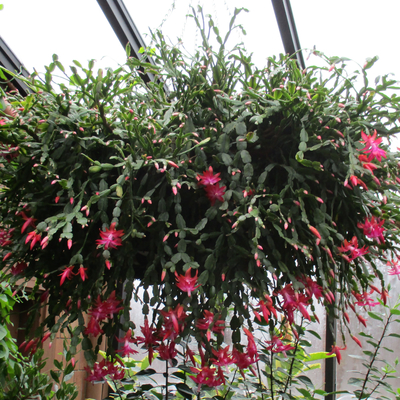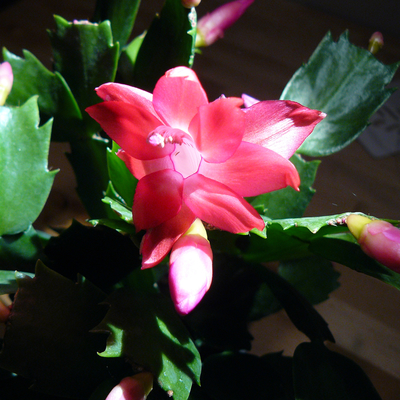Quick facts
- Holiday cacti have beautiful, exotic flowers and can live a long time.
- Examine holiday cacti for overall health and signs of pests before bringing indoors.
- To produce flower buds, they require shorter days and/or cool night temperatures.
- Holiday cacti will not grow well in heavy, wet soils.
- Fertilize monthly June thru August with a balanced houseplant fertilizer at half-strength.
Thanksgiving cactus (Schlumbergera truncata), Christmas cactus (Schlumbergera bridgesii), and Easter cactus (Schlumbergera gaertneri) are popular houseplants, often given as gifts during the holiday season. They are grown for their beautiful, exotic flowers.
Holiday cacti can be very long-lived. It is possible for these plants to live over 100 years, passed down from generation to generation. Although true cacti, these plants are native to rainforests.
The need for high humidity, bright but filtered light, and relatively moist soils for most of the year sets these plants apart from the majority of cacti and succulents. Well-drained soil and containers that have enough holes to allow water to easily drain are critical to plant health. Root rot (loss of roots due to overly wet soil) is one of the most common reasons these plants die.
People often complain about the lack of flower blooms. It is important to understand how light, temperature, and overall plant health affect blooming.
Though called Thanksgiving, Christmas and Easter cactus, these common names are only a general reference for the time of year these plants may bloom.
Growing holiday cacti
Holiday cacti are "short-day plants" meaning they produce flower buds when our hours of daylight decrease as we progress into winter. Cool night temperatures are also required.
Christmas cacti (S. bridgesii) and Thanksgiving cacti (S. truncata) will bloom after approximately 6 weeks of short days and flower in late fall to winter while Easter cactus (S. gaertneri) set buds after 8-12 weeks, flowering in late winter or early spring.
- Initiate buds by leaving plants outdoors in a protected location until just before frost danger.
- Shorter days and cooler nights signal the plant to produce buds, resulting in abundant blooms.
- Place holiday cacti indoors in a cool, bright location where daytime temperatures are 65-70° F and evening temperatures are 55-65° F.
- If plants are exposed to cooler night temperatures of 55° F, plants will bloom in approximately 5-6 weeks, sometimes regardless of the day length.
- If the night temperature is 60-65° F, these plants must have at least 12 hours of complete darkness every night for about 6 weeks in order to bloom.
- Plants are unlikely to bloom if exposed to night temperatures above 65° F.
- During the summer, put plants outside on a deck, patio, window box, etc. in part shade (3-6 hours of sunlight per day).
- Filtered sunlight, such as under a tree, is ideal as it mimics the plant's natural habitat.
- Excessive sunlight may result in pale green branches, drought and sunburn.
Before bringing plants indoors in the fall, examine holiday cacti for overall health and signs of pests.
- Identify, remove and treat for pests as necessary.
- Prune off diseased, broken or dead branches.
- Remove debris such as leaves from the soil surface.
- Make sure the container drains freely.
- Wipe the outside of the container with a damp cloth to remove insect eggs, bits of soil, cobwebs, etc.
- Holiday cacti require good drainage and aeration for healthy root growth.
- Holiday cacti bloom best when kept somewhat pot-bound.
- Healthy plants may only need repotting every three years.
- Recommended potting mix for holiday cacti:
- 1 part sterile potting soil
- 2 parts peat moss
- 1 part sharp/builder's sand or perlite
- Place plants in a sink to drain when watering.
- Remove excess water from saucers and decorative pots. Excess water may result in dropping flower buds, wilting and root rot.
- Allow soil to dry out between watering.
- Plants won't grow well in heavy, wet soils.
- Do not allow plants to sit in excess water after rainfall or watering.
- If water has been abundant (e.g heavy rainfall) and plants appear wilted, they may be suffering from too much water.
- Allow the plants to dry out, check the container for adequate drainage and relocate the plant to a drier, part shade site.
- After the plants have finished blooming, water less frequently, increasing again in spring or early summer when the plants resume more active growth.
- Fertilize monthly June thru August with a balanced houseplant fertilizer at half-strength.
- In the fall when flower buds are forming, change to a fertilizer with low nitrogen (N), and high phosphorus (P) and potassium (K) formulation.
- Example: 0-15-10 (0% N, 15% P, 10% K)
Once flower buds have started to develop, holiday cacti do not like to be disturbed.
- Plants may drop buds due to drafts or sudden changes in temperature or humidity levels.
- Direction and the amount of sunlight they receive can result in dropping buds.
- If the plants are to be put in a warmer room than the one in which the buds started, move them there as soon as the buds appear.
- As long as there is adequate light and a relatively cool night temperature, the flower buds should continue to develop normally. They will reward you with spectacular blossoms.
After flowering, prune plants to encourage branching.
- Use a small, sharp pruner or knife to cut plants where two branch sections (cladophylls) join.
- The plant will produce 1-2 new cladophylls where it was cut and increase its branching.
To propagate new plants from cuttings.
- Dip the base of the cutting in water and then rooting hormone.
- Plant the cutting in damp builder's sand or potting media that drains well.
- Place in bright light with temperatures of 70-80° F to promote good growth.
- Keep the potting soil moist, but not wet.
- After 2 weeks, use a small spatula or popsicle stick to gently lift the cutting and check for new roots.
- Once roots have formed, plant the cuttings in cactus soil.
- Water and place in a bright window.
Plant does not bloom
- Cause: Indoor temperature is too warm.
- Action: Lower room temperature to 55-65°F at night, 60-65°F during the day.
- Cause: The plant needs short days and long nights in a 24 hour time period.
- Action: Put the plant in total darkness for a minimum of 12 hours.
- Place in bright light for the remainder of each 24 hour period.
- Cause: The plant lacks nutrients.
- Action: Apply half-strength fertilizer with low N and high P and K in the fall.
Plant drops flower buds
- Cause: Changes in temperature.
- Action: Locate plant away from drafts, heaters and vents.
- Cause: Excessive number of buds for the plant to support. The plant is self-pruning.
- Action: Maintain good care — proper watering, fertilize at half-strength, bright light and cool temperatures.
Plant looks wilted even though the soil is wet
- Cause: Too much water causes roots to rot.
- Action: Allow the plant to dry out.
- Make sure container and potting media drain freely and the plant does not sit in water.
Plant drops branches
- Cause: The plant is very large and cannot support the weight of the branches.
- Action: Prune back some of the larger branches.
- Re-pot into a slightly larger pot.
Plant is brown and “corky” at base
- Cause: Normal plant aging.
- Action: Confirm this is not scale.
- Otherwise, no action is required.
Black, wet, slimy lesions that start at the soil line and progress upward to the top of branches
- Cause: Bacterial soft rot can cause branches to drop off, wilting and death of the plant.
- Action: Destroy infected plants.
- Keep watering to a minimum.
- Water at the base of the plant to avoid splashing bacterium from soil onto the plant.
Wilting, root and stem rot
- Cause: Root and stem rot caused by fungi. Foliage turns gray-green and the plant wilts. Stems rot at the soil line, branches drop off and the plant collapses. Roots are dark and mushy.
- Action: Purchase healthy plants.
- Avoid over-watering.
- Make sure pots and soil media drain well.
Blackened, circular sunken lesions
- Cause: Drechslera cladophyll rot (also called Helminthosporium cladophyll rot) caused by fungus Drechslera cactivora. Black spores on lesions are fuzzy in appearance.
- Action: Destroy infected plants.
- Keep watering to a minimum.
- Water at the base of the plant to avoid splashing fungal spores from the soil onto the plant.
Branch sections and roots die
- Cause: Fusarium cladophyll rot (Fusarium oxysporum). Causes tan lesions to form and infection at the borders of branch sections.
- Action: Destroy infected plants.
- Keep watering to a minimum.
- Water at the base of the plant to avoid splashing fungal spores from soil onto the plant.
Small flying insects that look like fruit flies
- Cause: Fungus gnats, which thrive in plant soil that is continuously wet.
- Action: Avoid overwatering plants.
- Allow soil to dry out between watering.
- Remove the plant from the soil, wash off roots, and re-pot in a clean container with fresh, sterile potting soil.
- Trap larvae with slices of raw potato placed on top of soil; discard potato regularly to remove larvae.
Reviewed in 2022








